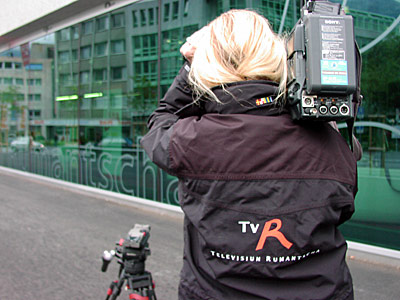Media bolsters wavering Romansh identity

Romansh newspapers, radio and television face many challenges as they try to cater to the needs of different Romansh speakers.
Propped up by subsidies, they have to fight hard to ensure their survival, while defending their role in promoting the language and helping to create a common identity.
The Romansh people, who are mostly based in the southeastern Swiss canton of Graubünden, have their own press agency, Agentura da Novitads Rumantscha (ANR), and daily newspaper, La Quotidiana.
And thanks to the public service Swiss Broadcasting Corporation, they also have their own radio and television stations, Radio Romansh (RR) and Television Romansh (TvR), part of Radio and Television Romansh (RTR).
RTR is located in Chur, the German-speaking cantonal capital, in a brand-new building that was inaugurated in June 2006.
“My project was to concentrate our strengths in one place to improve our visibility,” explained Bernard Cathomas, director of RTR since 2001. “If minorities are hidden away, they end up disappearing for ever.”
However, the rather closed mentality of the Romansh-speaking valleys meant that a “neutral” territory was needed.
“If we had decided to set up in one of the Romansh communes, the others wouldn’t have accepted it,” Cathomas told swissinfo.
While RR has its own radio station, TvR’s television programmes are broadcast on Swiss-German channels and then relayed via Swiss French- and Italian-speaking television.
“We don’t produce Romansh programmes just for ourselves. It’s also a way of showing the rest of the country that we exist. Switzerland’s fourth official language is not dying out,” said Cathomas.
Bridging divides
However, not so long ago the Romansh valleys did not communicate with each other – at least not in Romansh – claiming they did not understand each other’s idioms.
But things are changing, due in part to RTR, as each of the five Romansh idioms can now be heard on radio and television.
“People started to realise the five idioms were not really as different as they had first imagined,” said Ursin Lutz, editor of monthly youth magazine Punts.
“They had fixed ideas and were sure that they didn’t understand each other, but by listening to Romansh radio they realised this wasn’t true,”
Certain programmes use Rumantsch Grischun (RG), the controversial standard version of Romansh that Bernard Cathomas helped introduce when he was general secretary of Lia Rumantscha, the Romansh promotion organisation.
According to Andrea Rassel, who works for Lia Rumantscha, broadcasting has encouraged acceptance of RG.
“Some of the radio news is already in the standard language and people don’t notice because they are interested in the topics and not the language,” he told swissinfo.
Impact
The impact of traditional media is also far reaching, especially as many Romansh speakers, who are bilingual, are used to accessing news and information in German.
“It is very important to have a daily newspaper, because if you read about politics in German you tend to speak about it in German, but as soon a you can read about it in Romansh you start to talk about it in Romansh,” Rassel said.
According to Rassel, the media play an important role in promoting language because they also reach many non-Romansh speakers.
“They can show that Romansh can be sexy and that it doesn’t always have to be begging on its knees for help from outside,” he said.
Nevertheless, RTR’s existence is largely down to the Swiss Broadcasting Corporation’s special structure, with a budget that favours minority languages. Other media also have subsidies.
“I think the general public feels we waste lots of money and it could be better invested elsewhere. For them, Punts and RTR are for intellectuals. I don’t agree, but it’s hard to argue the contrary,” said Lutz.
“Approximately 60 per cent of Romansh speakers regularly listen to our shows – which is a lot,” added Cathomas. “The same people also listen to programmes in German. But if we stopped producing radio programmes in Romansh there would be a revolution.”
“One of RTR’s roles is to create a global Romansh identity. It’s a long-term process, but one that has already begun,” he said.
swissinfo, Bernard Léchot
Radio and Television Romansh (RTR) is part of the Swiss Broadcasting Corporation.
It employs 102 people full-time (2005)
Operating expenses (2005): SFr22.8 million ($18.5 million).
Radio Romansh (RR) is on air 14 hours a day.
Television Romansh (TvR) programmes are broadcast on Swiss-German television (SF), and then relayed via French- and Italian-speaking television (TSR and TSI).

In compliance with the JTI standards
More: SWI swissinfo.ch certified by the Journalism Trust Initiative
You can find an overview of ongoing debates with our journalists here . Please join us!
If you want to start a conversation about a topic raised in this article or want to report factual errors, email us at english@swissinfo.ch.